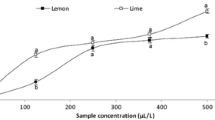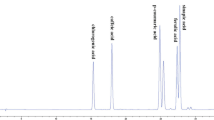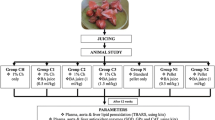Abstract
Fruit juices are commonly consumed in many parts of the world for their nutritional and medicinal benefits. More specifically, Pineapple (Ananas comosus), orange (Citrus sinensis) and watermelon (Citrullus lanatus var. lanatus) juices are used in folklore for the prevention and management of cardiovascular and neurodegenerative diseases, though there is dearth of information on the mechanism for such medicinal benefits. Thetrefore, this study sought to characterize the effect of these commonly consumed fruit juices on phosphodiesterase (PDE), monoamine oxidase (MAO) and angiotensin-I converting enzyme (ACE) activities in rat heart and brain homogenates. The fruits were sourced for and the juices extracted, freeze dried and then reconstituted for the analysis. The abilities of these juices to protect the heart and brain against Fe2+ induced oxidative damage were also investigated in vitro. The results revealed that the juices inhibited PDE, MAO and ACE activities in a concentration-dependent manner in rat heart and brain homogenates with orange having the highest inhibitory ability. The juices also inhibited Fe2+ induced malondialdehyde production in rat heart and brain in a concentration-dependent manner. This study revealed that the inhibition of these enzymes and prevention of oxidative damage could be part of the mechanisms by which these fruits could serve as dietary intervention for the prevention and management of cardiovascular and neurodegenerative diseases.




Similar content being viewed by others
References
Ademosun AO, Oboh G (2012) Inhibition of Acetylcholinesterase activity and Fe2+−induced lipid peroxidation in rat brain in vitro by some citrus fruit juices. J Med Food 15(5):428–434
Ademosun AO, Oboh G (2014) Comparison of the inhibition of monoamine oxidase and butyrylcholinesterase activities by infusions from green tea and some citrus peels. Int J Alzheimers Dis. doi:10.1155/2014/586407
Ademosun AO, Oboh G, Passamonti S, Tramer F, Ziberna L, Boligon AA, Athayde ML (2015) Phenolics from grapefruit peels inhibit HMG-CoA reductaseand angiotensin-I converting enzyme and show antioxidative propertiesin endothelial EA.Hy 926 cells. Food Sci Human Wellness 4:80–85
Baker GB, Matveychuk D, MacKenzie EM, Dursun SM, Mousseau DD (2012) Monoamine oxidase inhibitors and neuroprotective mechanisms. Bull Clin Psychopharmacol 22(4):293–296
de Bruijn RFAB, Ikram MA (2014) Cardiovascular risk factors and future risk of Alzheimer’s disease. BMC Med 12:130
Cases O, Seif I, Grimsby J, Gaspar P, Chen K, Pournin S, Muller U, Aguet M, Babinet C, Shih J (1995) Aggressive behavior and altered amounts of brain serotonin and norepinephrine in mice lacking MAOA. Sci 268:1763–1766
Ciobica A, Bild W, Hritcu L, Haulica I (2009) Brain renin-angiotensin system in cognitive function: pre-clinical findings and implications for prevention and treatment of dementia. Acta Neurol Belg 109:171–180
Cushman DW, Cheung HS (1971) Spectrophotometric assay and properties of the angiotensin I converting enzyme of rabbit lung. Biochem Pharmacol 20:1637–1648
Di Lisa F, Kaludercic N, Carpi A, Menabo R, Giorgio M (2009) Mitochondria and vascular pathology. Pharmacol Rep 61:123–130
Dias AT, Cintra AS, Frossard JC, Palomino Z, Casarini DE, Gomes IBS, Balarini CM, Gava AL, Campagnaro BP, Pereira TMC, Meyrelles SS, Vasquez EC (2014) Inhibition of phosphodiesterase 5 restores endothelial function in renovascular hypertension. J Transl Med 12:250–263
Duffy SJ, Biegelsen ES, Holbrook M, Russell JD, Gokce N, Keaney JF, Vita JA (2001) Iron chelation improves endothelial function in patients with coronary artery disease. Circ 103:2799–2804
Finberg JP, Gillman K (2011) Selective inhibitors of monoamine oxidase type B and the “cheese effect”. Int Rev Neurobiol 100:169–190
Francis J, Wei SG, Weiss RM, Felder RB (2004) Brain angiotensin-converting enzyme activity and autonomic regulation in heart failure. Am J Physiol Heart Circ Physiol 287:H2138–H2146
Grassi D, Desideri G, Ferri C (2010) Flavonoids: antioxidants against atherosclerosis. Nutrients 2:889–902
Green AL, Haughton TM (1961) A colorimetric method for the estimation of monoamine oxidase. Biochem J 78:172–176
Hryniewicz K, Dimayuga C, Hudaihed A, Androne AS, Zheng H, Jankowski K, Katz SD (2005) Inhibition of angiotensin-converting enzyme and phosphodiesterase type 5 improves endothelial function in heart failure. Clin Sci 108:331–338
Kametani F (2015) Phosphodiesterase as a drug target of Alzheimer’s disease. Austin Alzheimers J Parkinsons Dis 2(1):1021
Kelly SJ, Butler LG (1977) Enzymic hydrolysis of phosphonate esters. Reaction mechanism of intestinal 5′-nucleotide phosphodiesterase. Biochemist 16(6):1102–1104
Ko WC, Shih CM, Lai YH, Chen JH, Huang HL (2004) Inhibitory effects of flavonoids on phosphodiesterase isozymes from guinea pig and their structure–activity relationships. Biochem Pharmacol 68:2087–2094
Labandeira-Garcia JL, Rodriguez-Pallares J, Rodríguez-Perez AI, Garrido-Gil P, Villar-Cheda B, Valenzuela R, Guerra MJ (2012) Brain angiotensin and dopaminergic degeneration: relevance to Parkinson’s disease. Am J Neurodegener Dis 1(3):226–244
Montezano AC, Touyz RM (2012) Molecular mechanisms of hypertension- reactive oxygen species and antioxidants: a basic science update for the clinician. Can J Cardiol 28(3):288–295
National Institutes for Health (2011) Guide for the care and use of laboratory animals. The National Academies Press, Washignton, DC
Oboh G, Ademosun AO (2011) Shaddock peels (Citrus maxima) phenolic extracts inhibit a-amylase, a-glucosidase and angiotensin I-converting enzyme activities: a nutraceutical approach to diabetes management. Diabetes Metab Syndr Clin Res Rev 5(3):148–152
Oboh G, Ademosun AO (2012) Characterization of the antioxidant properties of phenolic extracts from some citrus peels. J Food Sci Technol 49(6):729–736
Oboh G, Ademosun AO, Akinleye M, Omojokun OS, Boligon AA, Athayde ML (2015) Starch composition, glycemic indices, phenolic constituents, and antioxidative and antidiabetic properties of some common tropical fruits. J Ethnic Food 2:64–73
Ohkawa H, Ohishi N, Yagi K (1979) Assay for lipid peroxides in animal tissues by thiobarbituric acid reaction. Anal Biochem 95:351–358
Orallo F, Camina M, Alvarez E et al (2005) Implication of cyclic nucleotide phosphodiesterase inhibition in the vasorelaxant activity of the citrus-fruits flavonoid (•})-naringenin. Planta Med 71:99–107
Peluso MR (2006) Flavonoids attenuate cardiovascular disease, inhibit phosphodiesterase, and modulate lipid homeostasis in adipose tissue and liver. Exp Biol Med (Maywood) 231(8):1287–1299
Pérez-Torres S, Cortés R, Tolnay M, Probst A, Palacios JM, Mengod G (2003) Alterations on phosphodiesterase type 7 and 8 isozyme mRNA expression in Alzheimer’s disease brains examined by in situ hybridization. Exp Neurol 182:322–334
Raasch W, Bartels T, Gieselberg A, Dendorfer A, Dominiak P (2002) Angiotensin I-converting enzyme inhibition increases cardiac catecholamine content and reduces monoamine oxidase activity via an angiotensin type 1 receptor-mediated mechanism. J Pharmacol Exp Ther 300:428–434
Rezvanfar MA, Rezvanfar MA, Ranjbar A, Baeeri M, Mohammadirad A, Abdollahi M (2010) Biochemical evidence on positive effects of rolipram a phosphodiesterase-4 inhibitor in malathion-induced toxic stress in rat blood and brain mitochondria. Pestic Biochem Physiol 98:135–143
Rodriguez-Rodriguez R, Simonsen U (2012) Measurement of nitric oxide andreactive oxygen species in the vascular wall. Curr Anal Chem 8:1–10
Santos C, Snyder PJ, Wu W, Zhang M, Echeverria A, Alb J (2017) Pathophysiologic relationship between Alzheimer’s disease, cerebrovascular disease, and cardiovascular risk: a review and synthesis. Alz Dementia Diag Assessment Dis Monitoring 7:69–87
Sprague AH, Khalil RA (2009) Inflammatory cytokines in vascular dysfunctionand vascular disease. Biochem Pharmacol 78(6):539–552
Sturza A, Leisegang MS, Babelova A et al (2013) Monoamine oxidases are mediators of endothelial dysfunction in the mouse aorta. Hypertension 62:140–146
Teloken PE, Mulhall JP (2008) Impact of phosphodiesterase type 5 inhibitors on endothelial function. Rev Urol 10(1):26–30
Turski W, Turska E, Grossbell M (1973) Modification of the spectrophotometric method of the determination of monoamine oxidase. Enzyme 14:211–220
Ugarte A, Gil-Bea F, García-Barroso C, Cedazo-Minguez Á, Ramírez MJ, Franco R et al (2015) Decreased levels of guanosine 3′, 5′-monophosphate (cGMP) in cerebrospinal fluid (CSF) are associated with cognitive decline and amyloid pathology in Alzheimer’s disease. Neuropathol Appl Neurobiol 41:471–482
Virdis A, Duranti E, Taddei S (2011) Oxidative stress and vascular dam-age in hypertension: role of angiotensin II. Int J Hypertens. doi:10.4061/2011/916310
Acknowledgements
The authors would like to thank Dr. S.A. Adefegha for his advice and encouragement during the drafting of the manuscript.
Author information
Authors and Affiliations
Corresponding author
Ethics declarations
Ethical Statement
The handling and use of the animals were in accordance with the National Institutes for Health Guide for the Care and Use of Laboratory Animals.
Conflict of Interest
The authors declare no conflict of interests.
Rights and permissions
About this article
Cite this article
Ademosun, A.O., Oboh, G. Effect of pineapple, orange and watermelon juices on phosphodiesterase, monoamine oxidase and angiotensin-I converting enzyme activities in rat heart and brain homogenates. Orient Pharm Exp Med 17, 269–276 (2017). https://doi.org/10.1007/s13596-017-0279-5
Received:
Accepted:
Published:
Issue Date:
DOI: https://doi.org/10.1007/s13596-017-0279-5




